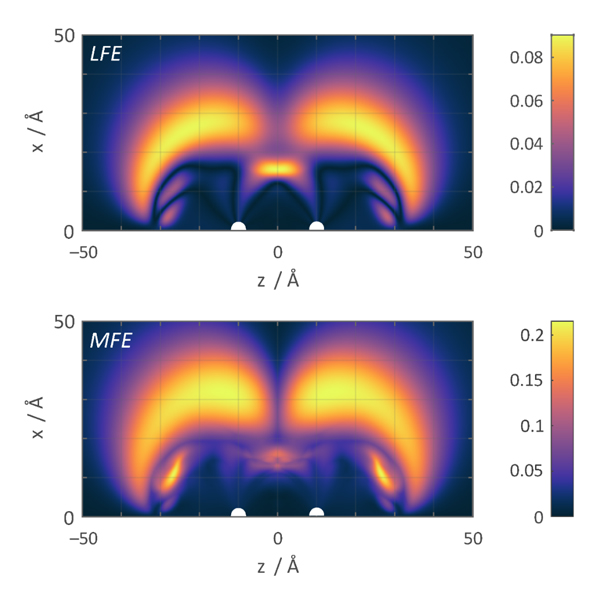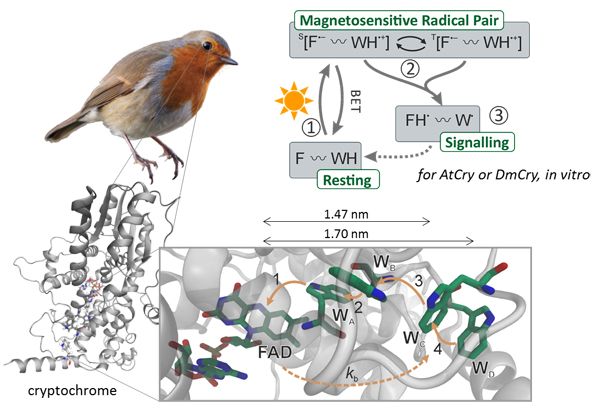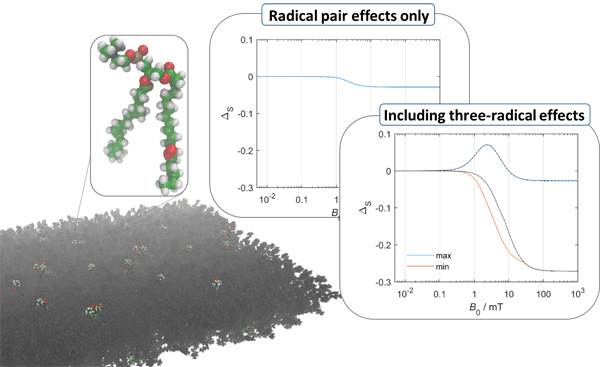Theory of magnetosensitivity
Research lead: Daniel Kattnig
Current projects
Dipolarly coupled spin-radicals
We have recently shown that in systems of three or more radicals, remarkable magnetic field effects can be induced by the electron-electron dipolar interaction alone – without involvement of hyperfine interactions, in stark contrast to what applies to radical pairs [1]. By considering the role of symmetries and energy level crossings, we have presented a model that demonstrates a directional sensitivity to fields weaker than the geomagnetic field. We achieve remarkable spikes in the reaction yield as a function of the magnetic field intensity that can be tuned by the exchange interaction. These results further our current understanding of weak-field reaction magnetosensitivity and could be particularly relevant to magnetic field effects on lipid autoxidation or the understanding of the putative effects of extremely low frequency (ELF) magnetic fields on biological systems.
Magnetic field effects (MFEs) in three-radical systems
In the figure below, we have assumed that two radicals (white semicircles) are located at a distance of 2 nm and varied the position of the third radical on a plane comprising the inter-radical axes of the first two radicals. Assuming a lifetime of 1 μs, we predict astonishing magnetic field effects for the singlet recombination yield of radical 1 and 2. For weak magnetic fields comparable to the Earth’s magnetic field (top), we predict MFEs of more than 8 %; more than 20 % are found for high magnetic fields (bottom). Remarkably, large effects are expected even if the distance of closest approach to the third radical approaches 5 nm, i.e. if the third radical assumes the function of a “casual bystander”.
[1] R. H. Keens, S. Bedkihal, and D. R. Kattnig, Phys. Rev. Lett. 2018, 121, 096001.

The avian quantum magnetic compass and magnetic field effects in cryptochromes

Evidence is accumulating that in certain birds (like the European Robin) and a few other animals, a magnetic inclination compass is based on a radical pair reaction in blue light-sensitive flavoproteins called cryptochromes. These magneto-sensors are supposed to be located in the retinae of the animals, where they possibly give rise to a magnetic-field dependent visual impression.
A possible reaction scheme (top right of the figure above) entails photo-excitation of the flavin cofactor, the formation of a spin-correlated radical ion pair by a succession of electron transfer reactions involving a triad or, in animals, tetrad of highly conserved tryptophan residues, its coherent interconversion between overall singlet and triplet states, and, eventually, spin selective recombination or spin-insensitive formation of a signalling state, possibly followed by the stabilisation of the flavin radical by proton transfer reactions and release of a C-terminal domain.
This reaction scheme is not the only possible reaction scheme discussed in the context of magnetoreception. However, it is the only scheme that is currently supported by in vitro experiments on the purified cryptochromes of the fruit fly and Arabidopsis thaliana. For these systems, the effect is known to originate from the radical pair involving the flavin anion radical and the radical cation of the third tryptophan of the triad or tetrad (see the insert at the bottom of the figure).
There are many unsolved enigmas associated with the radical pair hypothesis of magnetoreception, which we try to assess and resolve:
- How can the small effects induced by an Earth-strength magnetic field be amplified in order for the sensor to work with only 1 photon/s per cone outer segment?
- What process provides the remarkable acuity?
- Why is the effect sensitive to weak monochromatic or broadband radio-frequency magnetic fields, which would suggest a remarkable resilience to decoherence – much better than most man-made quantum device but operating at elevated temperatures in a noisy, biological environment?
- How does the sensor deals with the detriment of inter-radical interactions?
The chemical Zeno effect
Surprisingly, magnetic field effects can be vastly amplified if one of the radicals of the primary pair undergoes a spin-selective electron transfer reaction with a spin-bearing scavenger (chemical Zeno effect). This leads us to suggest new, extended reaction schemes for the putative magnetosensory protein cryptochrome [1,2]. The new mechanism offers clear and important benefits such as a greatly enhanced sensitivity to the orientation of a 50 μT magnetic field (by up to two orders of magnitude in the relative anisotropy) and magnetosensitivity for radicals that are more than 2 nm apart.
This means that radical pairs too distant to undergo spin-selective recombination reactions could also be viable magnetic compass sensors and that the detrimental effects of inter-radical exchange and dipolar interactions can be minimized. Even more surprisingly, the effect immunizes the sensor to fast decoherence processes in one of the radicals [2]. Consequently, magnetic field effects on radical pairs involving swiftly spin-relaxing species, such as superoxide, are no longer to be precluded [2].
[1] D. R. Kattnig and P. J. Hore, Sci. Rep. 7, 11640 (2017).
[2] D. R. Kattnig, J. Phys. Chem. B 121, 10215 (2017).

Oxidative degradation of lipids
A common denominator of the effects of weak magnetic fields on biological systems appears to be a modulation of reactive oxygen species and oxidative decay processes such as those associated with lipid autoxidation. This raises the question of the possibility of an inherent magnetic field effect on lipid peroxidation in general and the recombination of peroxyl radicals, the main chain carriers in the oxidative degradation of polyunsaturated fatty acids, in particular. We study the spin dynamics that could underlie these processes. Preliminary calculations suggest that magnetic field effects in these systems could be markedly enhanced through three-radical effects. These effects are predicted to give rise to magnetic field effect that, unlike the well-known effects due to radial pairs, depend on radical concentration. Furthermore, a peculiar dependence on field intensity in predicted.
Change of the recombination yield as a function of the magnetic field excluding (top, partly hidden) and including three-radical effects (right). The change in the recombination yield of the latter depends on the location of the third radical relative to the encountering pair and lies between the blue and red line. Under favourable conditions the magnetic field effects are predicted to be markedly larger than for the hyperfine induced effect in radical pairs.

